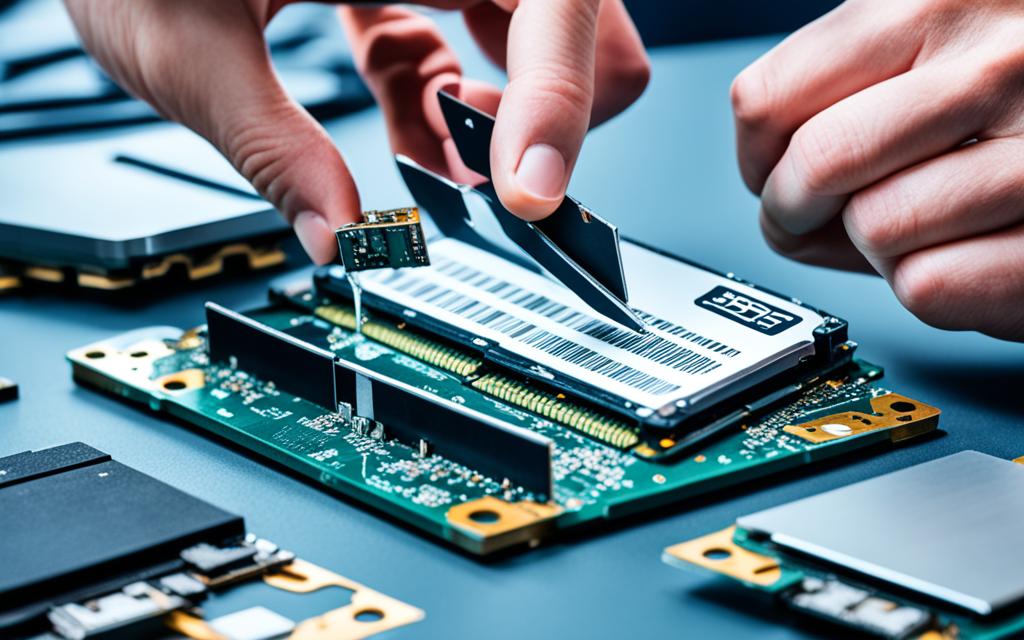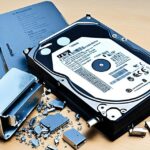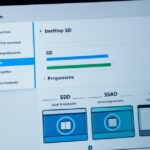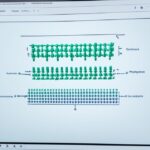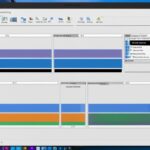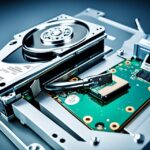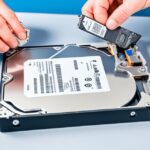Table of Contents
Managing your solid-state drive (SSD) well is key for the best performance. If you want to create more disk space or boost your system, understanding how to remove partitions on SSDs is vital. This article will show you how to delete partitions safely.
By getting the hang of this, you can improve your SSD’s capabilities. SSDs are famous for their fast speeds and durability. Learning to manage partitions can make your computing experience much better1.
Key Takeaways
- Understanding SSDs is key to effective management.
- Removing partitions is crucial for freeing up disk space.
- Different tools provide varying levels of ease when deleting partitions.
- Data backup is essential before making any deletions.
- Effective SSD management can significantly boost system performance.
- EaseUS Partition Master simplifies the partition removal process.
Understanding SSD Partitions
Solid-state drives (SSDs) are a big step forward in storing data. They work faster and last longer than old hard disk drives. The key to an SSD is its flash memory, which makes data access super quick and reduces delay because there are no moving parts. Knowing how SSD works is important for making the most of it, especially when you manage data by partitioning.
What is an SSD?
An SSD keeps information using non-volatile memory, making it perfect for running operating systems and applications. SSD features lead to quicker loading, faster data moving, and better reliability. These benefits make SSDs more popular in various devices, showing they are a better option for storing data.
Benefits of Partitioning an SSD
Partitioning an SSD has many advantages of partitioning SSD, mainly boosting system speed by separating types of data. For example, having one partition for the operating system and applications means they work faster and more smoothly, cutting down on wait times2. A big SSD partition benefit is better data safety and easy recovery. This happens by keeping important files away from OS and application files, which helps secure them if the system crashes2.
However, managing many partitions can be tricky. Things like resizing or making more room as your storage needs change can be hard without special software. Over time, organising data on an SSD can get complex2. Partitioning also lets you have more than one operating system on the same drive, giving you options on how you want to work2.
Even with its upsides, partitioning can lead to lack of space. Some partitions may end up too small or not used much2. Software like DiskGenius Free Edition helps a lot with managing SSDs. It can change partition size, split them, or join them together, making it less of a hassle for users with these problems2.
Reasons to Remove Partitions on Your SSD
Managing your SSD well can boost both available disk space and system speed. Knowing why deleting partitions for space is beneficial might lead users to better SSD storage management.
Freeing Up Disk Space
Removing partitions mainly free up SSD space. Users often find duplicated or unneeded partitions that take up essential storage. By merging data and getting rid of unused partitions, you can free up space. This space allows for better file management and application performance.
Improving System Performance
Deleting unwanted partitions can make your SSD perform better, giving a significant SSD performance boost. It makes data access quicker and reduces system load, leading to faster startups and app openings.
A well-performing SSD minimizes fragmentation and wear. Removing partitions can help with this. Tools like Disk Management make deleting partitions easy for users. This steps up the computing experience by ensuring your SSD works at its best.3
How to Remove Partitions on SSD
Before you start deleting partitions on your SSD, it’s crucial to prepare for SSD deletion. Begin by backing up data SSD to avoid losing important files. Doing these steps is important to prevent permanent data loss after removing partitions.
Preparation Steps Before Deletion
Make sure you have administrator rights before deleting anything. This access allows you to execute deletion commands correctly. Understanding the risk of SSD deletion is key. Carefully decide which partitions to remove and double-check that all important data is backed up. For help, look up online resources that explain the SSD deletion process and its importance.
Important Considerations
Be cautious during the deletion process. Deleting partitions wipes data for good and cannot be reversed. It’s crucial to think about how many partitions your SSD should have. The number should match your SSD’s capacity. For example, 1-3 partitions might be good for a 240-256GB SSD. A 1TB SSD might work better with 2-5 partitions41.
Method 1: Using EaseUS Partition Master
EaseUS Partition Master is a leading SSD partitioning tool. It’s known for its powerful, yet easy-to-use interface. Users can delete, resize, and merge disk partitions with ease. Its smooth workflow and intuitive design are great for both beginners and experts. This makes it a top recommendation for managing SSDs.
Overview of EaseUS Partition Master
Every year, over 4.5 million people trust EaseUS for partition management. It has been around for 19 years and has earned a 5-star rating from its users. This shows it’s both reliable and effective. The software supports different Windows versions, including Windows 11. It is also available in 20 languages and offers a 30-day money-back guarantee. With these offerings, you can feel confident in your purchase. You can select from various licenses, like the Professional version at $39.95 per license. There’s also a Technician version for businesses, which costs $699.00 for 10 or more users5.
Step-by-Step Instructions
To delete a partition with EaseUS, just follow these simple steps from the tutorial:
- Launch EaseUS Partition Master and go to the Partition Manager.
- Right-click on the partition you want to get rid of and choose “Delete.”
- Verify your choice by clicking “Yes” when asked.
- Then, click “Execute Task” followed by “Apply” to finish removing the partition. This method is straightforward, letting you handle multiple partitions at once easily.
Method 2: Deleting Partitions via Disk Management
To manage your SSD with Disk Management, use this essential tool. It’s found in Windows and gives an easy way to handle partitions. Just go to the Start menu to open Disk Management. It makes things like deleting an SSD partition simple, helping keep your storage neat.
Accessing Disk Management
Start by right-clicking the Start menu and choosing “Disk Management.” This brings up a window showing all drives and partitions. It makes it easy to see and pick the SSD partition you want to delete. You’ll be able to follow the right steps without trouble.
Detailed Deletion Steps
To delete a partition in Disk Management, follow these steps:
- Right-click on the SSD partition you want to remove and choose “Delete Volume.”
- Click “Yes” in the confirmation window that pops up.
- Remember, you can’t use this to delete active system partitions. Other tools might be needed for full SSD management.
Using this method helps get rid of partitions you don’t need. It boosts performance and frees up disk space. Even though Disk Management is useful, it’s not perfect for every task. Be careful when trying to delete complex partitions or the boot drive6.
Always keep these limits in mind when deciding how to manage your SSD partitions.
Method 3: Using Diskpart Command
For those who like using the command line, Diskpart is a great choice. It provides command line SSD management with lots of features. First, you need to open Command Prompt. Then, start the Diskpart program. This allows you to use Diskpart commands for SSD like deleting, resizing, and formatting partitions.
Accessing Command Prompt
To get to the Command Prompt, look for it in the Windows start menu. Then, right-click the icon and choose “Run as administrator.” This step is important to make sure you can do Diskpart deletion steps properly. It makes sure you have the permissions needed.
Step-by-Step Command Instructions
After getting into Command Prompt, follow these instructions:
- Type “diskpart” and press Enter to start Diskpart.
- Then, use the command list disk to show all discs.
- Find your SSD and type select disk X (replace X with your SSD’s number).
- Enter list partition to see all partitions on your SSD.
- To delete a partition, type select partition Y (replace Y with the partition number).
- Use delete partition to remove the selected partition.
- Type exit to leave Diskpart.
Using Diskpart for manage SSD with command line offers better control over your disk. It makes managing space and tasks easier than graphical tools do. Diskpart is a strong way to handle complex disk jobs more smoothly.
For more on building PCs and making sure parts work well together, look at this guide. Knowing how these tools work will help you manage your SSD better8.
Best Practices for Managing SSD Partitions
Efficient SSD management starts with backing up essential data. It’s crucial to protect your files before changing partitions. Use cloud storage or external drives for this. This step keeps your data safe when you delete partitions and gives peace of mind. Tools like MiniTool Partition Wizard Free are great for disk management. They support various operating systems, including Windows 11 and Windows 10. This makes them perfect for those wanting to optimise SSD usage easily9.
Backing Up Essential Data
A strong essential data backup strategy is key for SSD management. Before adjusting partitions, make sure important files are stored safely. This might mean moving files to secure them against errors or data corruption. When using Disk Management or Command Prompt to remove partitions, keeping data safe is critical10.
Managing Disk Space Efficiently
Managing SSD disk space efficiently means regularly checking partition sizes. Consider merging smaller partitions or resizing large ones as needed. Also, cleaning out unnecessary files, like those in the recycle bin, boosts SSD performance. By doing these, you not only prolong your SSD’s life but also keep your system fast and efficient. A mindful approach to storage keeps everything running smoothly11.
FAQ
What is an SSD and how does it work?
An SSD, or solid-state drive, is a data storage that uses flash memory. It stores data without moving parts. This means it can access data much faster, is more reliable, and has lower latency than traditional hard drives. SSDs are great for speeding up how quickly computers can read and write data.
Why is partitioning an SSD beneficial?
Partitioning an SSD helps organise data better and boosts system performance. It allows you to keep different types of data and backups separate. This makes your operating system run better and your data easier to manage. Properly managing partitions leads to a smoother running PC.
How can I free up space on my SSD?
You can free up space on your SSD by getting rid of unnecessary partitions. These may be too big or just extra copies. Doing so helps you organise your data better and use your SSD space more efficiently. Regular checks and clean-ups ensure optimal storage use.
What should I do before deleting a partition on my SSD?
Before deleting a partition, always back up important data to avoid losing it. Make sure you have the right to make these changes and understand what deleting a partition means. This action cannot be taken back. Good preparation protects your data.
What tools can I use for SSD partition management?
For managing SSD partitions, you can use tools like EaseUS Partition Master, Windows’ Disk Management, or Diskpart. They all have different features for deleting, resizing, or merging partitions. Pick the right tool based on the task complexity and how comfortable you are with the technology.
Q: How can I ensure the security of my important files during SSD management?
It’s key to back up important files to cloud storage or external drives to protect them. Regular backups ensure that your data is safe and gives you a safety net during the partitioning process.
What are the best practices for managing SSD partitions?
Good SSD partition management involves regularly checking and organising your data. You might need to merge small partitions or resize them based on use. Cleaning your SSD of unwanted files also helps. These steps improve your SSD’s life and your computer’s performance.
Source Links
- https://www.minitool.com/news/remove-partitions-on-ssd.html – How to Remove Partitions on SSD in Windows OS
- https://www.diskgenius.com/resource/partition-ssd.html – How to Partition SSDs in Windows 11/10/8/7? (4 Guides)
- https://4ddig.tenorshare.com/hard-drive/how-to-remove-partitions-on-ssd.html – How to Remove Partitions on SSD? 3 Quick Ways!
- https://www.easeus.com/partition-master/delete-partitions-on-ssd.html – How to Delete Partitions on SSD in Windows 11/10 [Step-by-Step Guide]
- https://www.easeus-software.com/partition-manager/ – EaseUS Partition Master – Best partition manager software for Windows PC and Server users.
- https://www.diskpart.com/diskpart/delete-partition-4125.html – [Tutorial]: Diskpart Delete Partition on Windows 11, 10, 8, and 7
- https://superuser.com/questions/1023765/how-to-delete-the-recovery-partition-in-windows-10 – How to delete the Recovery Partition in Windows 10?
- https://www.crucial.com/support/articles-faq-ssd/reset-ssd-with-windows-diskpart – Reset Your SSD With Windows DiskPart
- https://www.partitionwizard.com/free-partition-manager.html – Partition Wizard
- https://www.makeuseof.com/delete-drive-partition-windows/ – 4 Ways to Delete a Drive Partition on Windows
- https://www.lifewire.com/delete-windows-recovery-partition-4128723 – How to Delete a Windows Recovery Partition

